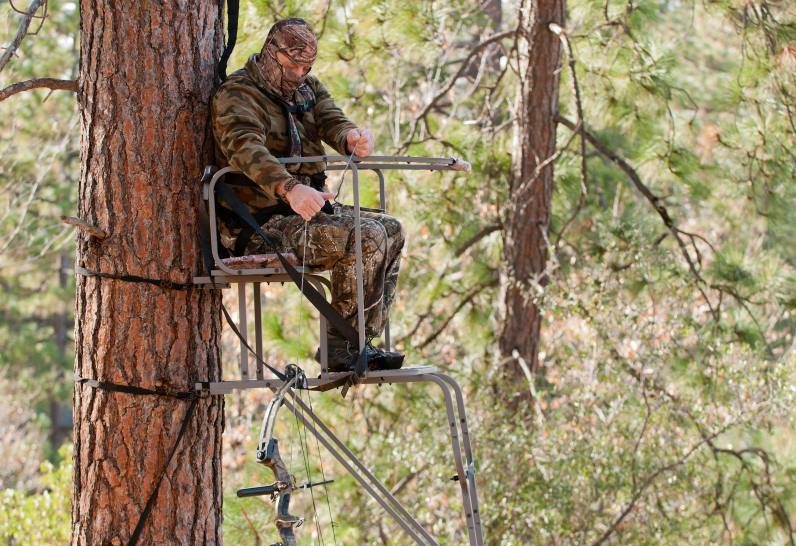Optimal Stand Placement

Optimal Stand Placement
As one season of hunting ends, most hunters begin to think of the next season within a few short days. That’s just what hunters do. It’s built-in. We are always looking ahead to the next hunt, the next season, the next opportunity to do the same thing all over again! Moreover, within all that thinking, hunters assess what went well and what didn’t go well regarding the season that just ended. We think of what we are going to do exactly the same way and what we need to change for the next season. You see, hunting is like a chess game. Sometimes you win, sometimes you lose. But you are always trying to analyze your opponent’s next move and that’s the real challenge that keeps us all walking into the timber every fall.
Observational Data – What Did You See?
I usually spend the off-season thinking back through my hunts and what I observed during my time in the woods. Maybe the deer kept moving through the timber 100 yards north of my stand during the season. Not allowing me the shot I thought I might get. What can I do to get closer to them next year? What’s going on that’s making the deer use that corridor? Do I need to think of the wind direction, bedding areas, and food sources? And don’t forget the most important thing, stand placement!
Learning how and where to place a stand is a vital part of a successful hunt. Especially if you’ve decided to go after a particular buck during the season. Placing your stand in the right place to intercept him is a key component to success. It is possible to have a high percentage of surety too if you think about all the other factors that come into play on successful stand placement.
Pattern
To place your stand in the right place, you first need to do a little homework. For me, that starts in the late winter or early spring. When snow is on the ground and antlers are falling, I begin to look for two specific things. First, I need to know that my target buck is still alive and in the area. To verify that, I begin to look for shed antlers by the end of January. If I can find that individual’s antlers, that’s a good sign. Often, I find a few “new” options also. Deer that might be harvestable in the upcoming season. Knowing which deer made it through the hunting season and the general area they are living in helps you begin to “mentally” place your stand.
The other bit of information I’m looking for is travel patterns. Deer trails can be found in the late summer and early fall. However, I would argue that they are most easily found in the late winter and early spring when the snow is clearly showing you how they are moving about. A muddy trail created through some beautifully white snow will tell you “by the tree” where these deer are running. Mapping these trails out with GPS or at least in your mind will lead you to a more precise place to set your stand.
Wind
Now that you know which deer are in the area as well as where and how they are moving, move on to the next step in placing your stand. This is arguably one of the most important things to spend some time thinking through. It will make or break your hunt as well as your very shot! The wind!
If you know your hunting area well, you should also know how the wind usually blows in that part of the property. Being as Iowa is flat, a high percentage of our wind comes from the west to the south. In my hunting area, the most common direction the wind blows is from the southwest due to the lay of the land and the topography.
If I want to hang a stand in this area, I need to look for a place that will allow me to hunt the travel corridor a high majority of days during the season. I want to know that in a week, I most likely could hunt that stand at least half or more than half the days in that week. Make sure that the stand is downwind of your target trail or the deer’s route of travel. If you accomplish that, make sure that when the season comes you do NOT hunt that stand until the wind is coming from the right direction.
Stand
In the last 30 years of hunting, the industry has been flooded with all kinds of options for stands. Single-ladder stands, double-ladder stands, climbing stands, sling stands, elevated blinds, hay bale blinds, and so many others. Truly, there’s a variety to choose from and all of them have their claims as to why they are the best. Choosing the one to use is up to you. Just remember, you want something sturdy and safe. Follow the directions when setting it up and do an annual maintenance check on them each year before you use them. Too many men and women have been injured or killed by silly things that could have been prevented.
It is important to think of where you place your stand once you’ve thought through my first couple of topics. The purpose of hunting from a stand is, essentially, to hide. To place yourself where the deer will not see you. The advantage of “ambush” is your method of hunting. Hunting from above a whitetail creates the perfect opportunity for hiding.
A deer has a few natural predators here in Iowa. The first is the coyote. The second, if they are brave enough, is the growing population of bobcats. I personally caught on my trail camera a bobcat jumping on the back of a fawn this last fall. My son-in-law took a cell phone video of a large bobcat chasing a doe through the timber in November. Both of these predators hunt a majority of the time, from the ground. The only exception would be the bobcats. Deer know this. Therefore, they are often looking at ground level for any danger. They are not typically looking in the trees.
When placing your stand, you need to make sure that your height is out of the normal visual range of deer. Erecting a stand on flat ground will usually put you high enough. Be mindful of hillsides or just over the edge of ravines. Depending on where the deer are traveling along their trails, you might just end up at eye-level with them. It’s not impossible to hunt that situation. You’ll need to be extra careful of your movement in the stand.
Choose Your Tree
Make sure that your stand is taking advantage of a good healthy tree too! Before you climb up or lean against the tree, observe its health. Are there lots of dead limbs? Is it leaning too much in one direction? Is it thick enough and strong enough to handle your weight and a stand weight? Are there any large holes or cracks in the tree’s trunk?
I once placed a stand in an ancient tree at the bottom of a ravine. I knew it was in a good place for a hunt. However, I took a gamble on the tree. It didn’t look the best, but I really wanted to get close to this trail. I came back a week later to hunt the stand and it was no longer there! What I mean by that is the tree had blown over and been uprooted! My stand was securely tied to the tree, smashed on the ground!
The tree you choose needs to be able to support your weight and the weight of the stand. Even if it’s a ladder stand that is “leaning” on the tree. Thicker trunks and healthy branches will lead to a more comfortable and safer sit. It will also eliminate the constant swaying sometimes causing “sea sickness”.
Once your stand is in the tree, be sure to cut some “shooting lanes” that would allow you proper shot placement if a deer followed your expected plan. But remember, you need to leave some foliage for your cover. Branches here and there will help enhance your camouflage. That’s the whole point, isn’t it? You don’t want to be seen. If you clear-cut the area, you are just exposing yourself to your quarry.
Conclusion
Now that the season is over, it’s time to think of next year. Get out there this spring and summer and make plans for where you’re going to set your stand up for next year. Pinpoint your deer and their travel patterns. Pay attention to the wind through the coming months. Find a good tree and get your stands set up in the first half of September. The longer a stand is in the timber, the more accustomed a deer becomes to it.
I hope you have a great time in the outdoors and playing the game of wits! Hopefully, it will prove successful next season!
By Ryan Graden
August 2025
Here are our other businesses check them out
Also check out this Article from the August 2025 issue as well
Also Here is a whitetail hunting story to try aswell
Also here is the Digital Issue August 2025
Looking for our Cattle/Dairy side of things?


